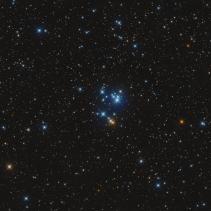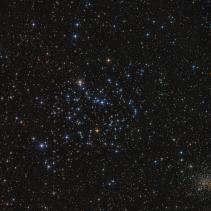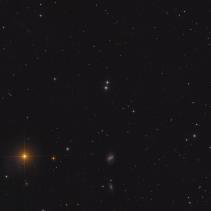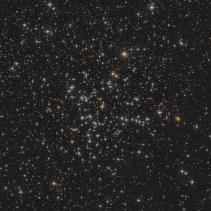Star clusters
NGC 2169
NGC 2169, is an open cluster in the Orion constellation. It was possibly discovered by Giovanni Batista Hodierna before 1654 and discovered by William Herschel on October 15, 1784. NGC 2169 is at a distance of about 3,600 light years away from Earth. It is nicknamed "The '37' Cluster" due to its striking resemblance to the numerals "37". The cluster is composed of components Collinder 38, a I3pn open cluster, and Collinder 83, a III3m open cluster.
R = 9 * 600 sec. bin1, G = 9 * 690 sec. bin1, B = 9 * 780 sec. bin1.
Pixinsight 1.8, Photoshop.
M 35 and NGC 2158
Messier 35 (also known as M35, or NGC 2168) is an open cluster in the constellation Gemini. It was discovered by Philippe Loys de Chéseaux in 1745 and independently discovered by John Bevis before 1750. The cluster is scattered over an area of the sky almost the size of the full moon and is located 850 parsecs (2,800 light-years) from Earth.
The mass of M35 has been computed using a statistical technique based on proper motion velocities of its stars. The mass within the central 3.75 parsecs was found to be between 1600 and 3200 solar masses (95 percent confidence), consistent with the mass of a realistic stellar population within the same radius.
The compact open cluster NGC 2158 lies directly southwest of M35.
R = 9 * 600 sec. bin1, G = 9 * 690 sec. bin1, B = 9 * 780 sec. bin1.
Pixinsight 1.8, Photoshop.
M 40
Winnecke 4 (also known as Messier 40 or WNC 4) is a double star in the constellation Ursa Major. It was discovered by Charles Messier in 1764 while he was searching for a nebula that had been reported in the area by Johannes Hevelius. Not seeing any nebulae, Messier catalogued this double star instead. It was subsequently rediscovered by Friedrich August Theodor Winnecke in 1863, and included in the Winnecke Catalogue of Double Stars as number 4. Burnham calls M40 "one of the few real mistakes in the Messier catalog," faulting Messier for including it when all he saw was a double star, not a nebula of any sort.
In 1991 the separation between the components was measured at 51.7", an increase since Messier's time. Data gathered by astronomers Brian Skiff (2001) and Richard L. Nugent (2002) strongly suggest that this is merely an optical double star rather than a physically connected system.
The nearby nebula observed by Hevelius may have been the nearby ring galaxy NGC 4290. The galaxy, being 12th magnitude, may have been bright enough to notice for large telescopes at the time, but not quite bright enough for Messier.
R = 14 * 400 sec. bin1, G = 14 * 480 sec. bin1, B = 14 * 560 sec. bin1.
Pixinsight 1.8, Photoshop, eXcalibrator.
M 38
Messier 38 (also known as M38 or NGC 1912) is an open cluster in the Auriga constellation.
It was discovered by Giovanni Batista Hodierna before 1654 and independently found by Le Gentil in 1749. M36 and M37, also discovered by Hodierna, are grouped together with M38 at a distance of about 3,420 light years away from Earth.
The cluster's brightest stars form a pattern resembling the Greek letter Pi or, according to Webb, an "oblique cross." At its distance of 4,200 light years, its angular diameter of about 20' corresponds to about 25 light years, similar to that of its more distant neighbor M37. It is of intermediate age (about 220 million years, according to Sky Catalog 2000) and features a yellow giant of apparent magnitude +7.9 and spectral type G0 as its brightest member. This corresponds to an absolute magnitude of -1.5, or a luminosity of 900 Suns. For comparison, the Sun would appear as a faint magnitude +15.3 star from the distance of M38.
R = 8 * 600 sec. bin1, G = 8 * 690 sec. bin1, B = 8 * 780 sec. bin1.
Pixinsight 1.8, Photoshop, eXcalibrator.




